Investigation of the Temperature and Horizontal Freezing Force of Loess in Three-Dimensional Freezing
Abstract
1. Introduction
2. Materials and Methods
2.1. Experimental Details
2.2. TPS Calibration Curve Test
3. Results and Discussion
3.1. Temperature Variation Pattern
3.2. Analysis of Freezing Force Test Results
3.3. Effect of Temperature on Freezing Force
4. Conclusions
Author Contributions
Funding
Institutional Review Board Statement
Informed Consent Statement
Data Availability Statement
Conflicts of Interest
References
- Won, J.; Lee, D.; Choi, H.-J.; Lee, H.; Choi, H. Field Experiments for Three Freezing Operation Scenarios in Silty Soil Deposits. Eng. Geol. 2022, 303, 106642. [Google Scholar] [CrossRef]
- Gong, W.; Quan, C.; Li, X.; Wang, L.; Zhao, C. Statistical Analysis on the Relationship between Shear Strength and Water Saturation of Cohesive Soils. Bull. Eng. Geol. Environ. 2022, 81, 337. [Google Scholar] [CrossRef]
- Bi, J.; Li, L.; Liu, Z.; Wu, Z.; Wang, G. Assessment and Enhancement of Soil Freezing Characteristic Curve Estimation Models. Cold Reg. Sci. Technol. 2024, 218, 104090. [Google Scholar] [CrossRef]
- Zhang, X.; Liu, S.; Wang, Q.; Wang, G.; Liu, Y.; Peng, W.; Xu, X.; Liu, Y. Experimental Investigation of Water Migration Characteristics for Saline Soil. Pol. J. Environ. Stud. 2019, 28, 1495–1505. [Google Scholar] [CrossRef]
- Lai, Y.; Pei, W.; Zhang, M.; Zhou, J. Study on Theory Model of Hydro-Thermal–Mechanical Interaction Process in Saturated Freezing Silty Soil. Int. J. Heat Mass Transf. 2014, 78, 805–819. [Google Scholar] [CrossRef]
- Liu, Q.; Zhang, Z.; Zhai, J.; Zhang, S.; Zhou, K.; Melnikov, A.; Gagarin, L. Geometric Form Changes of Soil Quartz Minerals under Freeze-Thaw Weathering. Eng. Geol. 2023, 320, 107133. [Google Scholar] [CrossRef]
- Zhang, M.; Zhang, X.; Lai, Y.; Lu, J.; Wang, C. Variations of the Temperatures and Volumetric Unfrozen Water Contents of Fine-Grained Soils during a Freezing–Thawing Process. Acta Geotech. 2020, 15, 595–601. [Google Scholar] [CrossRef]
- Wu, Z.; Jing, J.; Lu, Y.; Ma, W.; Pan, X.; Liang, C.; Chen, D. Study on Dynamic Response Characteristics of Compacted Loss Slope under Freeze-Thaw Cycles and Earthquake Loads. Cold Reg. Sci. Technol. 2024, 220, 104137. [Google Scholar] [CrossRef]
- Xiao, Z.; Zhu, L.; Hou, Z. The Change Mechanism and a Prediction Model of Unfrozen Water Content in Sodium Chloride Soil. Geoderma 2022, 419, 115881. [Google Scholar] [CrossRef]
- Zhang, Z.; Li, M.; Wen, Z.; Yin, Z.; Tang, Y.; Gao, S.; Wu, Q. Degraded Frozen Soil and Reduced Frost Heave in China Due to Climate Warming. Sci. Total Environ. 2023, 893, 164914. [Google Scholar] [CrossRef]
- Fang, J.; Li, X.; Liu, J.; Liu, C.; Liu, Z.; Ji, Y. The Crystallization and Salt Expansion Characteristics of a Silty Clay. Cold Reg. Sci. Technol. 2018, 154, 63–73. [Google Scholar] [CrossRef]
- Han, M.; Peng, W.; Ma, B.; Yu, Q.; Kasama, K.; Furukawa, Z.; Niu, C.; Wang, Q. Micro–Composition Evolution of the Un-disturbed Saline Soil Undergoing Different Freeze–Thaw Cycles. Cold Reg. Sci. Technol. 2023, 210, 103825. [Google Scholar] [CrossRef]
- Wang, C.; Li, K.; Chen, Q.; Ren, J.; He, X.; Li, S. Revealing the Freezing-Thawing Hysteretic Mechanisms of Soil–Water System Based on Soil Microstructure. Geoderma 2024, 449, 116986. [Google Scholar] [CrossRef]
- Zou, Y.; Jiang, H.; Wang, E.; Liu, X.; Du, S. Variation and Prediction of Unfrozen Water Content in Different Soils at Ex-tremely Low Temperature Conditions. J. Hydrol. 2023, 624, 129900. [Google Scholar] [CrossRef]
- Harlan, R.L. Analysis of Coupled Heat-fluid Transport in Partially Frozen Soil. Water Resour. Res. 1973, 9, 1314–1323. [Google Scholar] [CrossRef]
- Zhou, J.; Zhou, H.; Wang, C.; Guo, Z.; Pei, W. Analysis of Moisture Migration, Temperature, and Pore Structure Character-istics of the Muddy Clay Column Subject to Artificial Ground Freezing Based on LF NMR. Tunn. Undergr. Space Technol. 2023, 133, 104948. [Google Scholar] [CrossRef]
- Ma, X.; Cao, J.; Han, J.; Zhang, S.; Zhang, Y.; Yu, Q.; Yao, M.; Kou, J. Water–Salt Migration and Deformation Characteristics in Gravelly Sulfate Saline Soil under the Effect of Localized Fine Sand Accumulation. Cold Reg. Sci. Technol. 2024, 225, 104269. [Google Scholar] [CrossRef]
- Gao, J.; Lai, Y.; Zhang, M.; Feng, Z. Experimental Study on the Water-Heat-Vapor Behavior in a Freezing Coarse-Grained Soil. Appl. Therm. Eng. 2018, 128, 956–965. [Google Scholar] [CrossRef]
- Ji, Y.; Zhou, G.; Zhou, Y.; Hall, M.R.; Zhao, X.; Mo, P.-Q. A Separate-Ice Based Solution for Frost Heaving-Induced Pressure during Coupled Thermal-Hydro-Mechanical Processes in Freezing Soils. Cold Reg. Sci. Technol. 2018, 147, 22–33. [Google Scholar] [CrossRef]
- Ji, Y.; Zhou, G.; Hall, M.R. Frost Heave and Frost Heaving-Induced Pressure under Various Restraints and Thermal Gradi-ents during the Coupled Thermal–Hydro Processes in Freezing Soil. Bull. Eng. Geol. Environ. 2019, 78, 3671–3683. [Google Scholar] [CrossRef]
- Hao, X.; Ma, W.; Feng, W.; Wen, Z.; Zhang, L.; Chen, S. Investigation on the Frost Heave-Induced Pressure and Hy-dro-Thermal Processes in Freezing Soil under Rigid Constraint and Hydraulic Pressure. Eng. Geol. 2023, 323, 107238. [Google Scholar] [CrossRef]
- Changjian, T.; Zongyan, S. Horizontal Frost Heave Thrust Acting on Buttress Constructions. Eng. Geol. 1981, 18, 259–268. [Google Scholar] [CrossRef]
- Tianyuan, Z.; Jianming, Z.; Hu, Z.; Qi, Z.; Shuo, W. Measurement of Tangential Frost Heaving Stress for Steel Pile in Clay Silt. Cold Reg. Sci. Technol. 2022, 198, 103541. [Google Scholar] [CrossRef]
- Li, X.; Cheng, G. A GIS-Aided Response Model of High-Altitude Permafrost to Global Change. Sci. China Ser. Earth Sci. 1999, 42, 72–79. [Google Scholar] [CrossRef]
- Liu, K.; Xu, C.; Zhang, X. Measurement Performance Evaluation of Tactile Pressure Sensor with Different Particle Sizes and Sensor Curvatures. Geotech. Test. J. 2021, 44, 1036–1054. [Google Scholar] [CrossRef]
- Palmer, M.C.; O’Rourke, T.D.; Olson, N.A.; Abdoun, T.; Ha, D.; O’Rourke, M.J. Tactile Pressure Sensors for Soil-Structure Interaction Assessment. J. Geotech. Geoenviron. Eng. 2009, 135, 1638–1645. [Google Scholar] [CrossRef]
- Lai, Y.; Wu, D.; Zhang, M. Crystallization Deformation of a Saline Soil during Freezing and Thawing Processes. Appl. Therm. Eng. 2017, 120, 463–473. [Google Scholar] [CrossRef]
- Wang, C.; Li, S.; Lai, Y.; Chen, Q.; He, X.; Zhang, H.; Liu, X. Predicting the Soil Freezing Characteristic From the Particle Size Distribution Based on Micro-Pore Space Geometry. Water Resour. Res. 2022, 58, e2021WR030782. [Google Scholar] [CrossRef]
- Hajimohammadi, M.; Hamidi, A. Impact of Portland Cement and Lime on the Stabilization and Shear Strength Character-istics of Contaminated Clay. Soil Sediment Contam. Int. J. 2023, 32, 337–362. [Google Scholar] [CrossRef]
- Zhang, Y.; Liu, W.; Wang, J.; Wang, M.; Zhu, D.; Dong, Y. Experimental Study on Frost Heave Characteristics and Mi-cro-Mechanism of Fine-Grained Soil in Seasonally Frozen Regions. Cold Reg. Sci. Technol. 2023, 216, 103990. [Google Scholar] [CrossRef]
- Wang, H.; Wu, Y.; Wang, M.; Li, X. Influence of Fines Content and Degree of Saturation on the Freezing Deformation Characteristics of Unsaturated Soils. Cold Reg. Sci. Technol. 2022, 201, 103610. [Google Scholar] [CrossRef]
- Liu, Z.; Liu, J.; Li, X.; Fang, J. Experimental Study on the Volume and Strength Change of an Unsaturated Silty Clay upon Freezing. Cold Reg. Sci. Technol. 2019, 157, 1–12. [Google Scholar] [CrossRef]
- Ma, W.; Wang, D.Y. Studies on frozen soil mechanics in China in past 50 years and their prospect. Chin. J. Geotech. Eng. 2012, 34, 625–640. [Google Scholar]
- Kalantari, M.; Dargahi, J.; Kövecses, J.; Mardasi, M.G.; Nouri, S. A New Approach for Modeling Piezoresistive Force Sensors Based on Semiconductive Polymer Composites. IEEEASME Trans. Mechatron. 2012, 17, 572–581. [Google Scholar] [CrossRef]
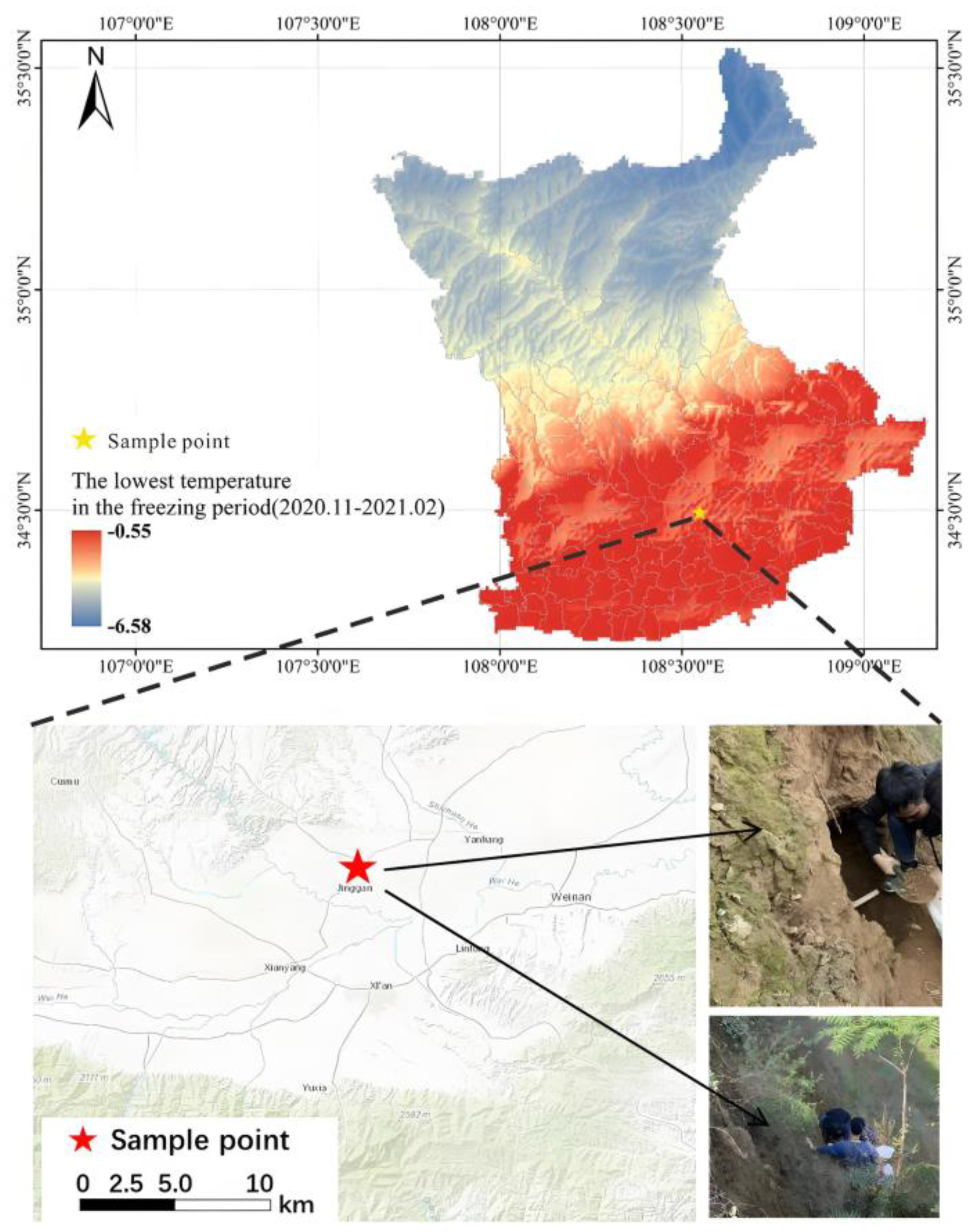
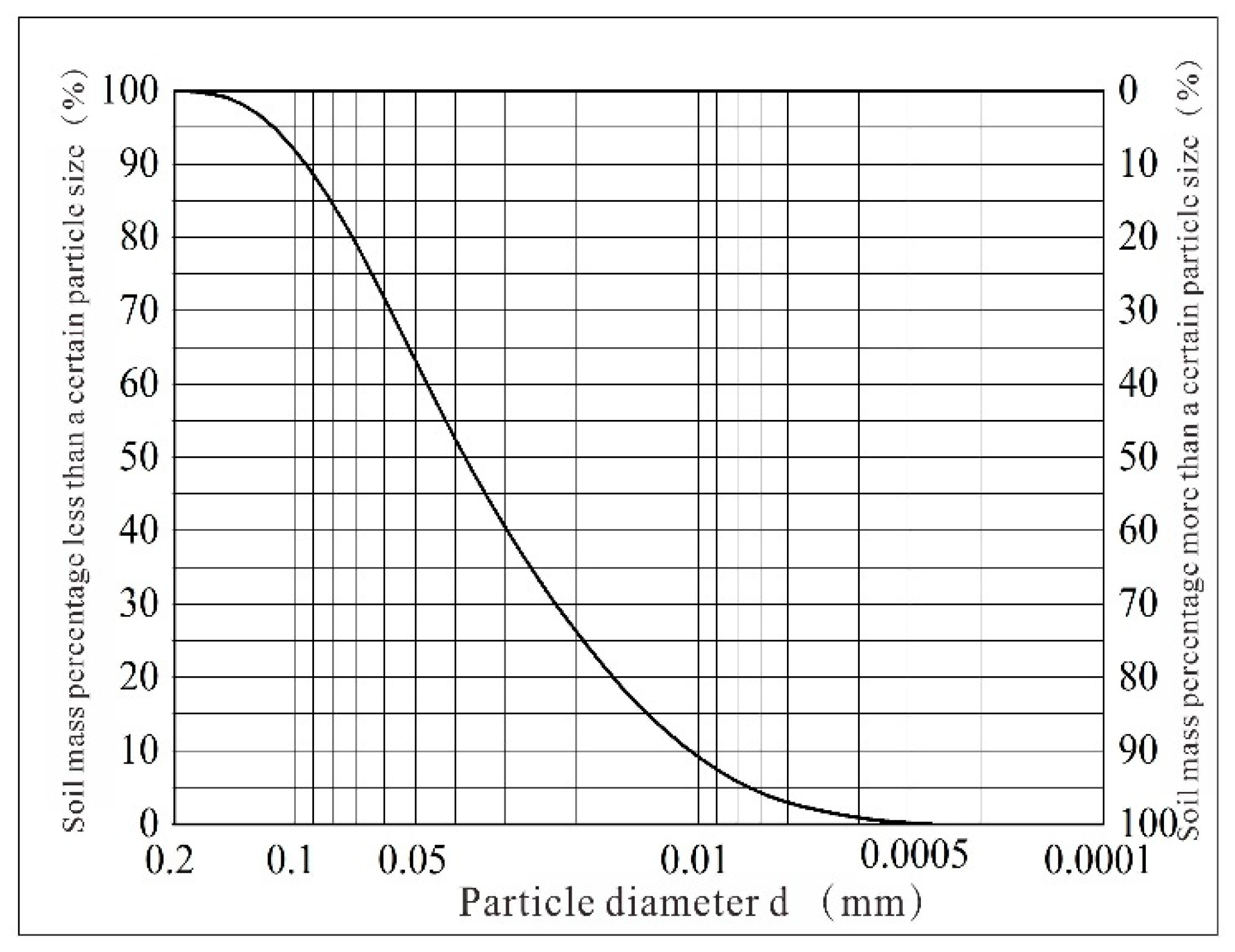


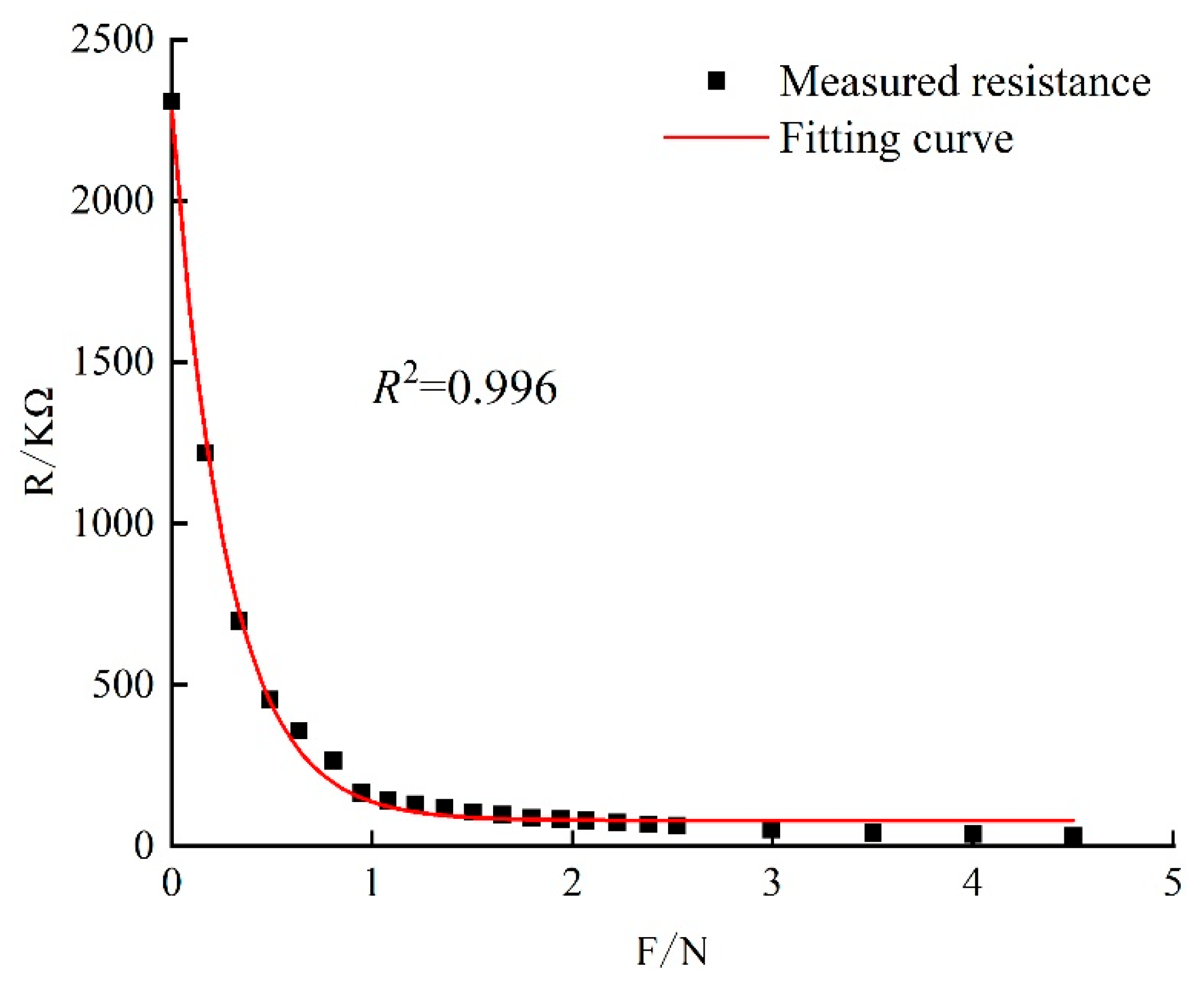
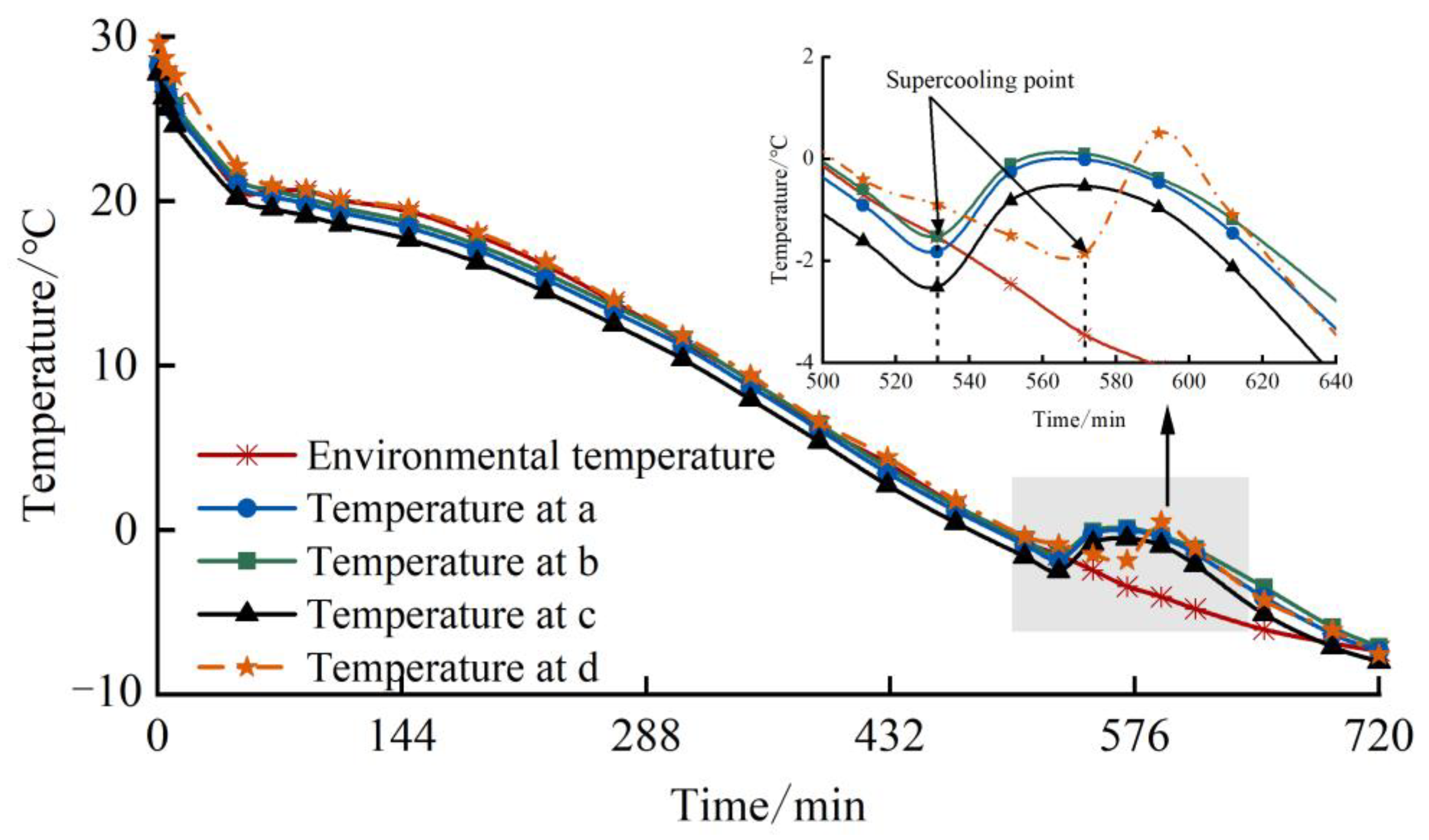

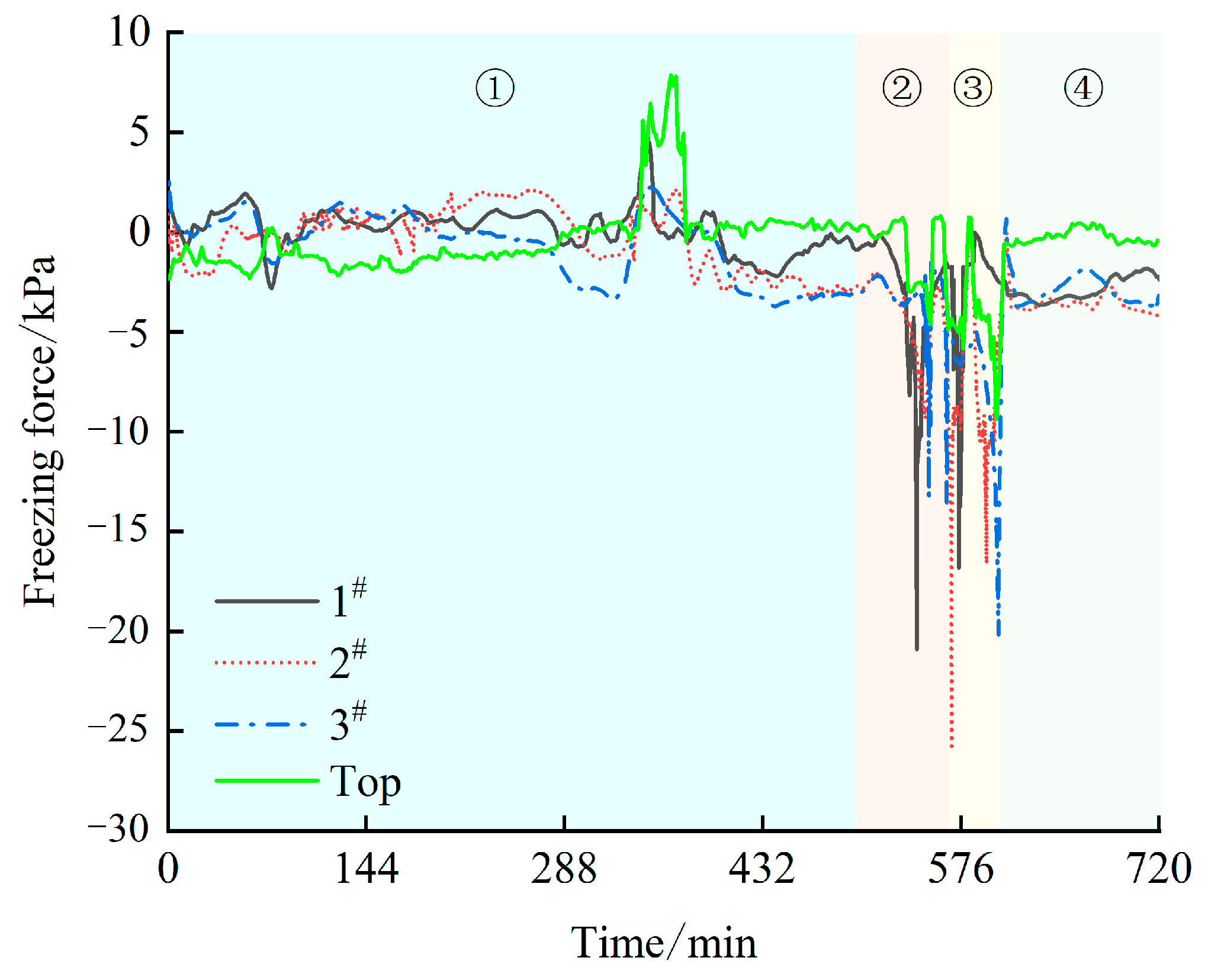

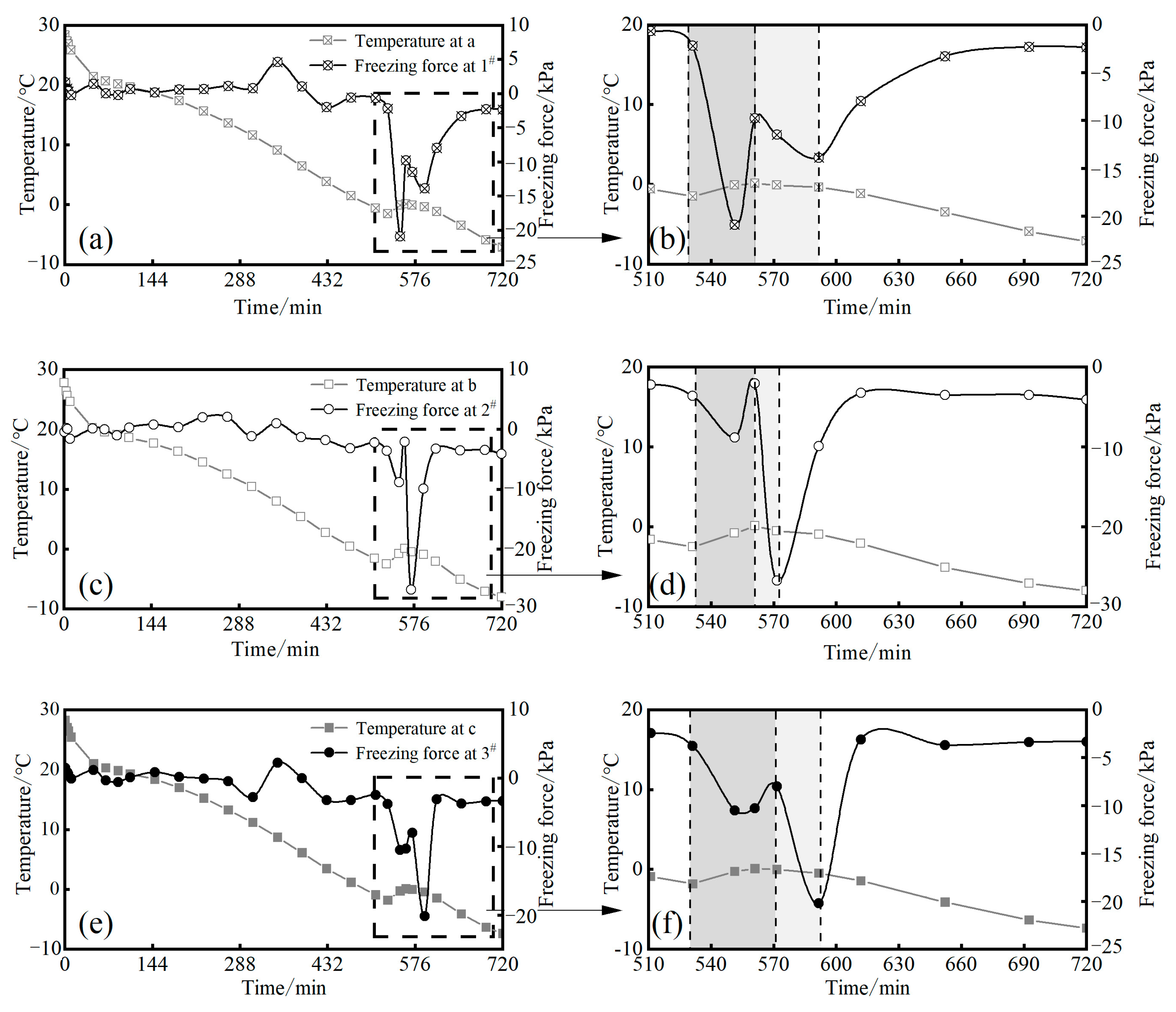
| Natural Water Content /% | Dry Density /g∙cm−3 | Optimum Moisture Content /% | Maximum Dry Density/g∙cm−3 | Liquid Limit % | Plastic Limit/% | Liquidity Index% | Plasticity Index % |
|---|---|---|---|---|---|---|---|
| 14.9 | 1.59 | 17.5 | 1.7 | 29.6 | 18.6 | −0.3 | 11.3 |
Disclaimer/Publisher’s Note: The statements, opinions and data contained in all publications are solely those of the individual author(s) and contributor(s) and not of MDPI and/or the editor(s). MDPI and/or the editor(s) disclaim responsibility for any injury to people or property resulting from any ideas, methods, instructions or products referred to in the content. |
© 2024 by the authors. Licensee MDPI, Basel, Switzerland. This article is an open access article distributed under the terms and conditions of the Creative Commons Attribution (CC BY) license (https://creativecommons.org/licenses/by/4.0/).
Share and Cite
Yin, Y.; Liu, F.; Tang, D.; Chen, L.; Yang, B. Investigation of the Temperature and Horizontal Freezing Force of Loess in Three-Dimensional Freezing. Materials 2024, 17, 4614. https://doi.org/10.3390/ma17184614
Yin Y, Liu F, Tang D, Chen L, Yang B. Investigation of the Temperature and Horizontal Freezing Force of Loess in Three-Dimensional Freezing. Materials. 2024; 17(18):4614. https://doi.org/10.3390/ma17184614
Chicago/Turabian StyleYin, Yidan, Fei Liu, Dongqi Tang, Longze Chen, and Binbin Yang. 2024. "Investigation of the Temperature and Horizontal Freezing Force of Loess in Three-Dimensional Freezing" Materials 17, no. 18: 4614. https://doi.org/10.3390/ma17184614
APA StyleYin, Y., Liu, F., Tang, D., Chen, L., & Yang, B. (2024). Investigation of the Temperature and Horizontal Freezing Force of Loess in Three-Dimensional Freezing. Materials, 17(18), 4614. https://doi.org/10.3390/ma17184614






